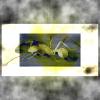So cool. "Myrmecodia species from the family Rubiaceae have the most highly specialized inner chambers, divided into smooth-walled chambers, which are used by ants for nurseries, and rough-walled chambers, used for waste disposal, insect prey remains, and bodies of dead ants from the colony."
"All of these waste products stored within the rough-walled chambers begin to decompose when moisture is present, and are then broken down by microbial activity and the nutrients are then taken up by intrusive adventitious roots or absorbed through wall linings.... [D]isproportionately large numbers of ant heads, containing the most nutritionally dense parts of the ant, are found in large numbers within these chambers."
"Myrmecodia plants produce small, juicy fruits from their one or two leaves and flowers per plant. Seeds will be dispersed following the ingestion and passing of the seed as waste product by a bird, or more commonly, ants will remove the seeds from the fruit by chewing on the fruit. If a bird does get to the seed first, the ants will retrieve the seeds from the ground below, return the seeds to the nesting spot, and plant them on their substrate to continue growing their colony with more housing."
If only they were transparent. That would so awesome lololol
Edited by OhNoNotAgain, July 19 2020 - 10:33 AM.
Formiculture Journals::
Veromessor pergandei, andrei; Novomessor cockerelli
Camponotus fragilis; also separate journal: Camponotus sansabeanus, vicinus, quercicola
Liometopum occidentale; Prenolepis imparis; Myrmecocystus mexicanus
Pogonomyrmex subnitidus and previously californicus
Tetramorium sp.
Termites: Zootermopsis angusticollis
Isopods: A. gestroi, granulatum, kluugi, maculatum, vulgare; C. murina; P. hoffmannseggi, P. haasi, P. ornatus; V. parvus
Spoods: Phidippus sp.













